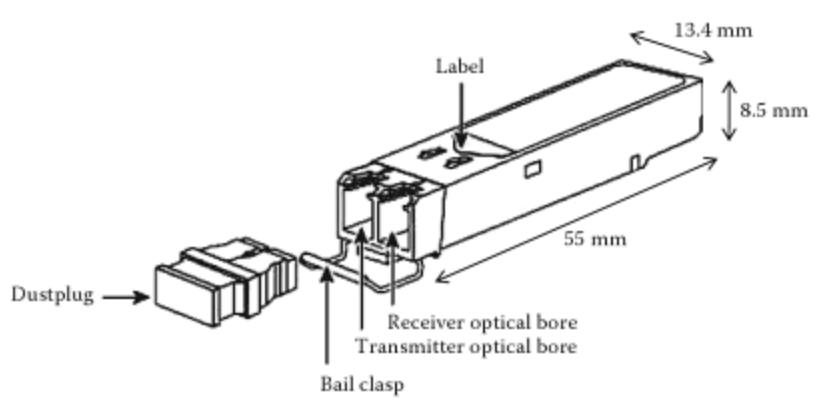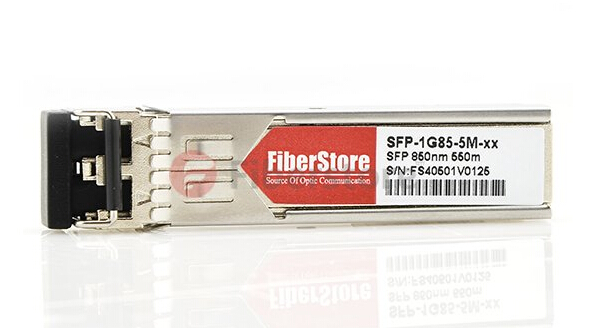SFP Transceivers for Telecommunications
The SFP is the more compact optical transceiver used in optical communications. It interfaces a network equipment mother board to a fibre optic or unshielded twisted pair networking cable.
This is probably the most diffused transceiver format available with a variety of different transmitter and receiver types, allowing users to select the appropriate transceiver for each link to provide the required optical reach over the available optical fibre (e.g., multimode fibre or single-mode fibre).
A drawing of a SFP transceiver is presented in Figure 1, where the particular connector for the input and output fibres that, with different dimensions, is present in all the transceivers is evidenced.

Figure 1. A drawing of a SFP transceiver
Optical SFP modules are commonly available in four different categories:850nm (SX), 1310nm (LX), 1550nm (ZX), and WDM, both DWDM and CWDM. SFP transceivers are also available with a copper cable interface, allowing a host device designed primarily for optical fibre communications to also communicate over unshielded twisted pair networking cable.
Commercially available transceivers have a capability up to 2.5 Gbit/s for transmission applications; moreover, aversion of the standard with a bit rate of 10Gbit/s exists, but it can be used only to connect nearby equipment, and is very useful to spare space and power consumption as interface in the client cards of line equipments.
Modern optical SFP transceivers support digital optical monitoring functions according to the industry standard SFF-8472 MSA. This feature gives the end user the ability to monitor real-time parametres of the SFP, such as optical output power, optical input power, temperature, laser bias current, and transceiver supply voltage.
SFP transceivers are designed to support SONET, Gigabit Ethernet, Fibre Channel, and other communications standards. A 1000 BASE SX SFP shown in Figure 2.

Figure 2. 1000BASE-SX SFP 850nm
One common query we hear is actually one must use a Cisco SFP with Cisco hardware? The answer is “not really” although that is not the answer Cisco wants to give. Perhaps you have used third-party compatible SFPs for your networking, and the price gap is obvious.
Brand’s SFPs And Third-Party Compatible SFPs
Brand’s SFPs such as Cisco, Cisco wants their customers buying only Cisco hardware, which is to say the least more expensive than anyone else on the market. They conduct their own optical transceivers, and try very hard to convince buyers that only official Cisco hardware will work.
Actually, a few of their hardware such as the Catalyst line will not even access third-party SFPs without running undocumented commands first!
That said, it’s simple enough to figure around. Plus, either way, the plain truth is that one optical transceiver from a reputable vendor is just as good as any other. It’s a totally standardized technology, like spark plugs, and one brand’s SFP is going to work fine with any other brand’s hardware.
And, like with spark plugs, few people beyond enthusiasts really care about the brand as long as the SFP works once installed.
When you are intending to upgrade your network, it makes sense to “cut corners” when those corners really aren’t even being cut at all. Third-party SFP optical transceivers usually cost far less than the “official” units, especially in the case of Cisco, but could supply the exact same performance you’d expect.
To get more brand compatible optical SFP transceivers, or other fibre optics equipment and any other questions you might have about your future networking needs, please don’t hesitate to contact FS.COM for everything you need to know!
